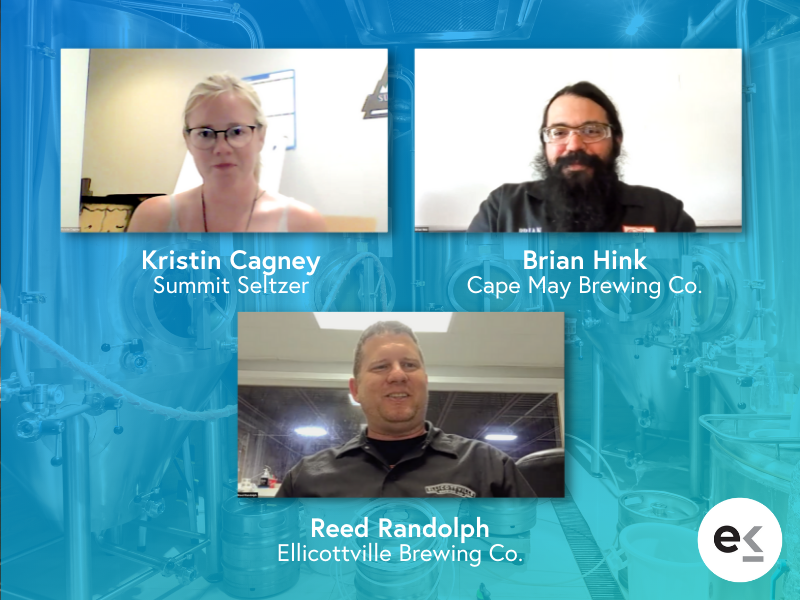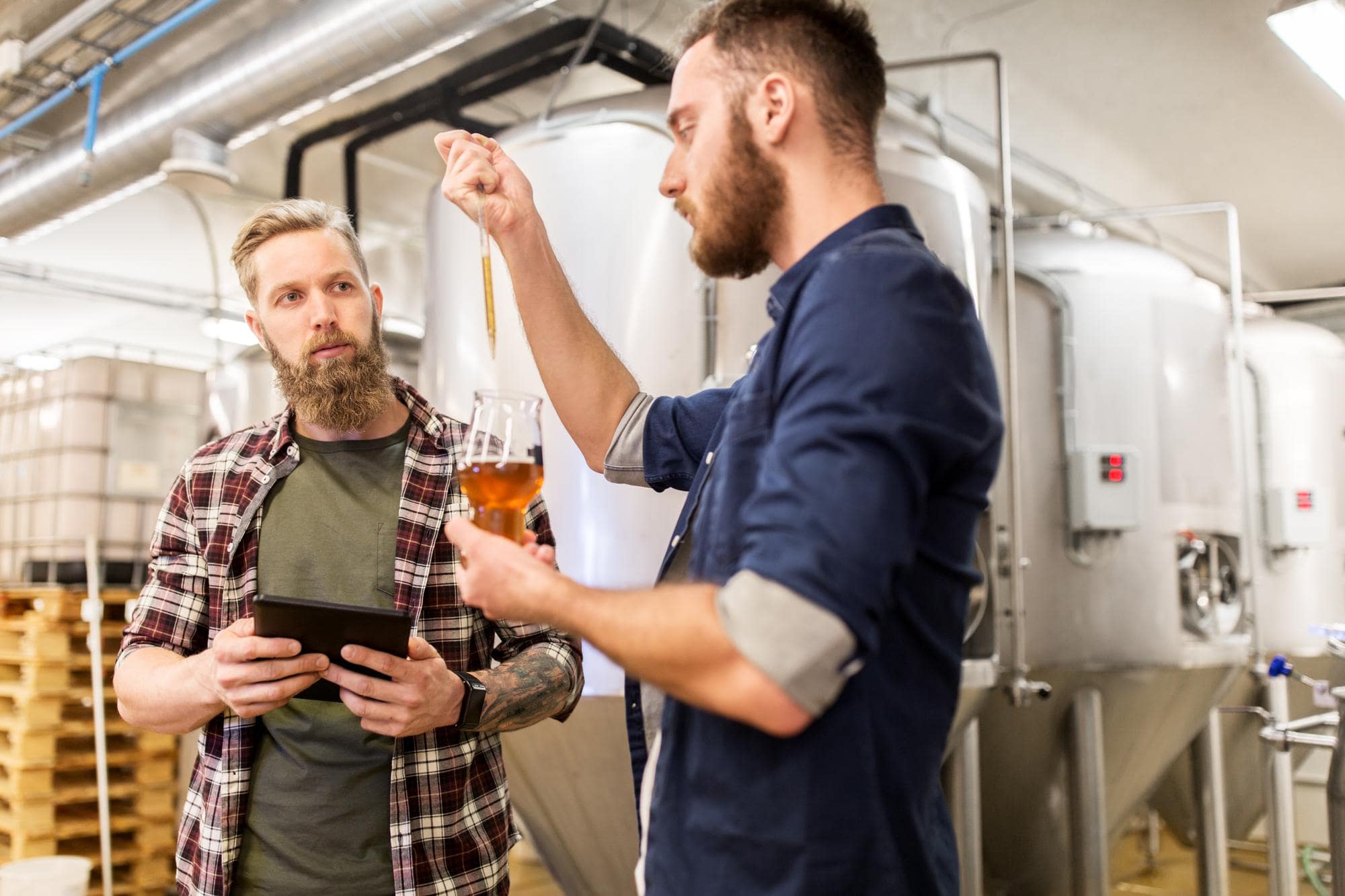Recently, Ekos’s Landon Funsten had a chat with seltzer brewers Kristin Cagney (Summit Seltzer), Brian Hink (Cape May Brewing Company), and Reed Randolph (Ellicottville Brewing Company) about why they started making seltzer and how they do it. Check out the highlights of the panel discussion below. Note: Dialogue has been edited for length and clarity.
Rather watch than read? You can view the recording any time — the interactive discussion clocks in at less than an hour.
Q: Kristin, you’ve been making seltzer with Summit since last year. You talked a little bit about wanting to create something different within the scope of the Charlotte beer scene. What ultimately landed you on seltzer and and what have you learned going into that process?
Kristin: I worked at a couple of the breweries here in Charlotte and I was running a lot of the marketing behind the scenes as well as just bartending. It was insightful being on the front lines of everything, really getting that consumer feedback. One of the questions that we got from so many of them was, “What do you have that’s not beer?” and “What do you have that’s gluten-free, low-carb, low-calorie?” I was actually in my MBA program at the time, and we did a market research and analytics class specifically focused on seltzer trends and brewery sentiments. So, we got a good array of data that showed that seltzer was the future. This was back in 2018, and I didn’t see that trend going anywhere.
Q: Brian and Reed, your stories will almost inherently differ by nature of the fact that Cape May and Ellicottville had such well-established beer brands. So, what made you decide to get into seltzer and when did you ultimately pull the trigger?
Brian: At Cape May, we’re in a resort area of New Jersey. We’re always in a summer mindset — that beachy active lifestyle. We will see thousands of people in a day sometimes come through our tasting room, so we wanted to have an offering for those people that were looking for the more health-conscious thing.
When we started playing with seltzers about two years ago, we started out on draft just doing some small batches to see how we could handle the process. We wanted to make sure we could do something different and put our own spin on it, so one of the early things we decided to do out of the gate was use real fruit in the seltzers. So, a lot of our seltzers have a very distinctive color. On draft, it actually really helped because people would see that from across the bar and be like, “Oh cool, what’s that?”
And then after a year of fine-tuning that, we did some small batch canning of it last summer and then it’s gone out for wholesale distro this year in variety packs, because we knew that we had a product on our hands that we wanted to push forward. Our sales team loves it and they’re really pushing it hard, so we just kept scaling it up. The seltzers are fun because it just gives us a different sandbox to play in.
Reed: Two things drove the decision. First, at the beginning of 2020, a brand had gone out of business in New York state called Empire, and it had a lot of followers and good beer. So, we acquired that brand and then the pandemic hit. Then, towards the summer, our distributors came to us and said, “We can’t get White Claw. We can’t get Truly. Is there something you guys can do?” We researched how to make the seltzer and did all the flavor tests and everything, and so we came out with the Empire [seltzer] brand for New York state so we could help that brand along and bring some more attention to it and expand closer to New York City. We felt that would resonate well with our customer base.
Q: Ellicottville has its core beer brand; Empire exists as a separate seltzer brand. At Cape May, conversely, beer and seltzer exist under the same brand. What drove those branding decisions?
Reed: We think that there’s a lot of crossover between the craft beer drinker and the seltzer drinker, so it wasn’t really like we wanted to differentiate ourselves or protect one brand from the other brand. It was just trying to expand our footprint.
Brian: It was very much on brand out of the gate for us. Seltzer really just kind of fell in line for us, and we had a lot of positive brand equity [in the Cape May brand] with that whole vacation mindset and “shore town” feel. It just made sense to let that fold into the seltzer products as well.
Q: Have you noticed any material difference in marketing seltzer? Was there anything that surprised you and what trends do you feel like have emerged in engaging with your consumer audience?
Kristin: For us, it’s quite a bit different than breweries that have an entirely different line of beverage with their seltzers versus beer. With marketing for the seltzery, we’ve been trying to find where we land since we’re so new. Finding that sweet spot has been interesting — we kind of make fun of ourselves. I mean, we have tank tops and stickers that say “Bitches love seltzer” and so we definitely make fun of it being a basic drink but it’s so much more than that. We really want to focus on being inclusive. Last week, we did a big event at this gun range and then I came back and we hosted a drag show. We literally are all over the board with who our consumers can be. If you like drinking, you like an active lifestyle, you like to have fun and feel a little less guilty about it — those are the people that we’re really trying to attract.
Q: What have you seen in terms of who’s buying seltzer? What products specifically have been most popular?
Brian: We’ve definitely seen a lot of interest in the wholesale market in our same stores that we already are in with our flagships. All of our wholesale seltzer we have in variety packs, and people are gobbling them up. In the tasting room, we decided to sell the individual flavors on their own and that’s been a fun way to see which flavors are resonating the most and which are the more popular ones. It’s a lot of the same buyers that are coming in and buying our crazy one-off beers — those same consumers are also grabbing the seltzers. The craft beer purists are coming on board [with the idea of seltzer] in droves and I think you’re seeing it more and more.
Reed: Our customer base [ranges] from college bros to women in their 40s and 50s and 60s. And like Brian was saying about the “beer purists,” I probably was in that boat. But as somebody who’s a geriatric millennial, I enjoy drinking seltzer now. We have a second location on a dock essentially and people will come up and want the seltzer. They’re just happy to drink it and relax. It’s pretty much for everybody in my opinion.
Q: What about packaging strategy?
Brian: Our core seltzers are in 12-oz. cans. In the tasting room those are six-packs and then out in the wholesale market they are mixed variety packs with three of each flavor. We talked about slim cans early on, but the changeover parts to go to slim cans were astronomical [in price]. And we just didn’t want to deal with the supply chain issues.
Reed: We went with slim cans, and then we ran into the supply chain issues. On the production side, we wanted the packaging not to be that completely white packaging (like Truly and White Claw), and the sales team was like, “No, it needs to be white.” Then you go into your local grocery store, and it’s a wall of white — it’s hard to differentiate yourself. So, I would suggest having a unique design or a color to your variety pack.
Brian: That was something we chose to do with the liquid. Like I was saying, we add real fruit juice to it and so it has a lot of bright color. We wanted to reflect that with the packaging, so our variety pack is very colorful and it definitely stands out.
Kristin: We just got two new 30-barrels in, so we tripled our production capacity. We have a lot of on-premise accounts but we just have traditional beer four-packs. We haven’t pushed cans yet — we’ve just been really pushing kegs. I know it’s difficult for us because in the tap room right now we can sell four-packs for 15 bucks, but no one’s going to pay for that at a grocery store when they can get a 12-pack of Truly or White Claw for $13.99. It’s challenging trying to figure out the right move. Our neighborhood grocery stores have been knocking on our door to get into their space, but we don’t want to go in there completely blind and ruin that relationship because they’ll remember that, and we won’t be able to get back in. So we’re trying to take our time, as difficult as that is.
Q: What have you learned through the seltzer production process and how different is it from making beer?
Brian: It’s very similar — there’s a lot of the same equipment we’re using and a lot of the same tanks. But it has its own unique set of challenges. When you produce seltzer, you either target the volume to be like a finished product or you can make a higher-alcohol base and then dilute down. We went for the higher ABV base that we then will blend away with water. So the way that we do it does require more tanks that we have to go in and out of to blend the base and the water to dilute to the ABV, and to then add the flavors, and then centrifuge and filter. It just requires a little bit more planning.
Reed: Ours is the same process. The [seltzer] brewing process is relatively quick compared to beer — the challenge is having all the tanks ready to go on the back end for your different flavors. The logistics part is tricky.
Kristin: We’ve been exploring a lot of different things. We actually have a little one-barrel R&D system and we mess around a lot with different fruits and flavorings. There’s a lot of different ways to do it but the fun part is you just start right in the fermenter. You don’t have to boil or wort or mash, so it is a little bit easier and cleaner.
Q: Seltzer sales grew 8x from 2018 to 2020 and 28% of Ekos customers are now making seltzer. What’s your outlook on craft seltzer? Does it continue to grow, or is there a plateau upcoming?
Kristin: Everyone’s guess is as good as mine, but I would say I think that it’s going to hold its category pretty strong for a long time. It fits with a different lifestyle, and I see a lot of trends too with millennials and Gen Z shifting away from drinking in general, so that’s a big thing. This whole health and wellness craze, I don’t see that going anywhere anytime soon. So, since seltzer fits with that category, I think it’s going to do just fine.
Brian: Following the overall beer world, it’s going to take a similar track where the big guys hold the main share of the market. I don’t think it’s going to go away at all though because it’s just such a diverse style. Us being craft brewers, we’re just creative. When we have an itch, we’ve got to scratch it.
Reed: Even if it does plateau at this level, I think it’s worth it to get into it. It’s ubiquitous, I would say. I think the market’s going to mature and so people will be looking for higher-concept flavors just like in the craft beer industry, where people want hoppier beers or pastry beers. Seltzer’s just another avenue that can be delivered.
Kristin: As all the other craft seltzers start being more unique, it’ll just blow up from there. Because once [consumers] have options that are much different [from each other], they’re going to start being — well, hopefully not as hardcore as some of the beer snobs, but we’ll get some seltzer snobs for sure. Eventually.
Looking for More Seltzer Content?
Watch the full webinar to hear the panelists discuss:
- Handling divided opinions internally about whether to move into seltzer
- Changing production equipment to accommodate demand
- Deciding whether to use fruit purees or natural flavors in your seltzer, and how to balance the sweetness
You can also download The Rise of Seltzer: A Brief Guide for Brewers to learn more about the hard seltzer industry, labeling and compliance considerations, and what factors to think about if you decide to start producing it at your facility.



